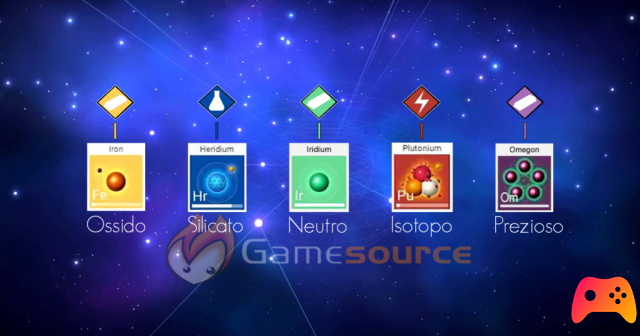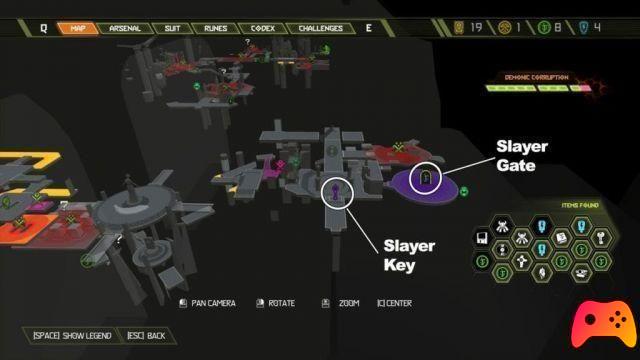
Like any self-respecting survival, in No Man's Sky There are many different materials that you will have to collect to build increasingly powerful objects and continue your exploration. The main elements are 23 and it is possible to find them in many different places and in different shapes. What we propose today is a guide that will help you recognize and know how to find the various materials in the infinite space of No Man's Sky.

The elements are divided into 5 categories, which will have different roles:
- Oxides: Oxides are used in crafting and to reload defensive technologies. In the menu and in the periodic table they are characterized by a yellow background behind the composition of the element. When you use the scan they will be marked with diamond-shaped icons, with a yellow background and a white ingot in the center.
- Silicates: Silicates are usually used in combination with other elements, such as Plutonium, to create many other objects and materials. They are presented in the menu and in the periodic table with a blue background behind the composition of the element. They are marked on the compass and in the game world, after a scan, as blue icons in the shape of a diamond with a white flask in the center.
- Isotopes: They are mainly used as gasoline or refill for virtually all technologies in No Man's Sky (spaceship engines, weapons, shields and hyperdrive), but they also have a strong use in crafting. In menus and in the periodic table they are shown with a red background behind the composition of the element. After using the scan you will see them marked on the screen with red rhomboid icons with a white lightning bolt in the center.
- neutral: Neutral elements are only useful for crafting purposes when used in combination with other materials. In the menu and in the periodic table they have a green background behind the composition of the element. After a scan they will be indicated with a green diamond icon with a white ingot in the center.
- Precious: You can sell these items at a good price in shops around the space. They will be shown in the menu and in the periodic table with a purple background behind the composition of the element. When scanning the planet they will be shown with a purple rhomboid icon with a white ingot in the center.

How to find and recognize the various materials
Each of the aforementioned groups contains several elements. The latter are located in space and on the planets. They don't always have the same shape or are placed in the same points, but there are guidelines that more or less respect in every planet in the universe.
Oxides:
- Iron (Fe): Among the most common materials of space, iron can be collected from small rocks or from large, elongated and very high hexagonal deposits. It is not unusual to find it even among meteorites. You can also get it by dismantling some items. Used in multiple basic and advanced crafting recipes.
- Sulfur (S): It is easily found in nature, both from plants and from rocks. Useful for making grenades.
- Zinc (Zn): Very useful for reloading defensive matrices. You will find it inside the plants (usually yellow and flashy), dismantling some objects or even for sale by shopkeepers.
- Titanium (Ti): It is usually found on the hottest planets and groups in large yellow crystalline formations. It is used to reload defensive technologies and to create advanced components.
Silicates:
- Eridio (Hr): The Eridium deposits are characterized by rectangular and very high rocks, impossible to miss. As if that were not enough they will be highlighted by your scanner. Used in crafting Multi-Tool upgrades.
- Platinum (Pt): Virtually every plant with blue flowers that you encounter on the various planets will have platinum inside. Useful for crafting grenade upgrades and gear.
- Silicon (Si): By interacting with blue plants with bulges you will get this element. It is used to create hyperdrive and other very useful technologies.
- Crisonite (Ch): Crisonite deposits are characterized by blue crystalline formations. This element is very useful, as it will be used to create new technologies and technological enhancements.
Isotopes:
- Carbon (C): Carbon is mainly contained on the surface of the planets within the vegetation. You will often use it to recharge your extractor and exotuta.
- Thamium9 (Th): Take a look at our guide on the Thamium9 to get all the information you need on this element.
- Plutonium (Pu): Perhaps the most common material and one of the first that you too will have encountered. Plutonium deposits are structured like tall, pointed red crystals. This element is mainly used as a fuel for the spacecraft, but also for the creation of some useful objects (such as electron vapor).
Neutral:
- Copper (Cu): Obtained by destroying some asteroids that are larger and bluish than the other more common ones in Thamium9. You may also find it on planets in rare floating rocks (Be careful not to land on it!). Very useful in crafting many items, including Multi-Tool upgrades.
- Nickel (Ni): You can get it by destroying particular asteroids or feeding animals. Useful for crafting a couple of upgrades.
- Iridium (Ir): Read our guide to know everything about Iridium.
- Gold (Au): Excellent conductor. Particularly rare on some planets, when grossly common on others. This is why in some galaxies you can sell it for astronomical figures, while in others for nothing.
- Aluminum (Al): Located on the ground and very often close to Plutonium. It can often be sold for a very high price, but is also very useful in crafting.
- Emeril (Em): Common in radioactive planets, you will find it in dark metal deposits. Useful for some crafting recipes.
Precious:
- Potassium (K): You may find it by killing Blob-shaped creatures. Being very rare you can sell it to many units from the shopkeepers.
- Omegon (Om): As with all elements in this category the Omegon is very rare. You may find it by letting animals guide you by feeding them. It is usually found in very small rocks on the ground, useful for creating the black matter or for being sold at a high price.
- Radnox (Ra): Usually located in flying rocks on the most radioactive and dangerous planets. You could also get it by killing some flying creatures. It can be sold at a very high price.
- Murrine (Mu): You can collect it in planets or moons from large piles of golden spheres or very rarely by feeding animals. Salable at exorbitant prices.

If you want to become a master of No Man's Sky check out our other guides too:
10 things to know about No Man's Sky
No Man's Sky - How to farm Thamium9 fast
No Man's Sky - How to farm units easily
No Man's Sky - Where to find the Iridium
No Man's Sky - How to move faster with the Jetpack
No Man's Sky - Multiply inventory items with a bug
No Man's Sky - How to find and create antimatter
No Man's Sky - What to do when dead






